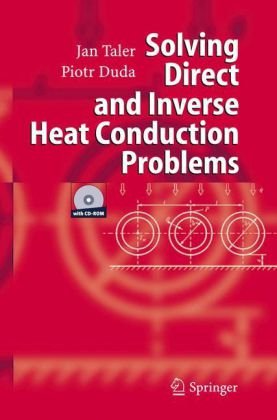

Most ebook files are in PDF format, so you can easily read them using various software such as Foxit Reader or directly on the Google Chrome browser.
Some ebook files are released by publishers in other formats such as .awz, .mobi, .epub, .fb2, etc. You may need to install specific software to read these formats on mobile/PC, such as Calibre.
Please read the tutorial at this link: https://ebookbell.com/faq
We offer FREE conversion to the popular formats you request; however, this may take some time. Therefore, right after payment, please email us, and we will try to provide the service as quickly as possible.
For some exceptional file formats or broken links (if any), please refrain from opening any disputes. Instead, email us first, and we will try to assist within a maximum of 6 hours.
EbookBell Team

4.3
48 reviews 
ISBN 10: 354033470X
ISBN 13: 978-3540334705
Author: Piotr Duda Jan Taler
This book is devoted to the concept of simple and inverse heat conduction problems. The process of solving direct problems is based on the tempera ture determination when initial and boundary conditions are known, while the solving of inverse problems is based on the search for boundary condi tions when temperature properties are known, provided that temperature is the function of time, at the selected inner points of a body. In the first part of the book (Chaps. 1-5), we have discussed theoretical basis for thermal conduction in solids, motionless liquids and liquids that move in time. In the second part of the book, (Chapters 6-26), we have discussed at great length different engineering problems, which we have presented together with the proposed solutions in the form of theoretical and mathematical examples. It was our intention to acquaint the reader in a step-by-step fashion with all the mathematical derivations and solutions to some of the more significant transient and steady-state heat conduction problems with respect to both, the movable and immovable heat sources and the phenomena of melting and freezing. Lots of attention was paid to non-linear problems. The methods for solving heat conduction problems, i. e. the exact and approximate analytical methods and numerical methods, such as the finite difference method, the finite volume method, the finite element method and the boundary element method are discussed in great detail. Aside from algorithms, applicable computational programs, written in a FORTRAN language, were given.
Front Matter
Heat Conduction Fundamentals
Fourier Law
Mass and Energy Balance Equations
The Reduction of Transient Heat Conduction Equations and Boundary Conditions
Substituting Heat Conduction Equation by Two-Equations System
Variable Change
Exercises. Solving Heat Conduction Problems
Heat Transfer Fundamentals
Two-Dimensional Steady-State Heat Conduction. Analytical Solutions
Analytical Approximation Methods. Integral Heat Balance Method
Two-Dimensional Steady-State Heat Conduction. Graphical Method
Two-Dimensional Steady-State Problems. The Shape Coefficient
Solving Steady-State Heat Conduction Problems by Means of Numerical Methods
Finite Element Balance Method and Boundary Element Method
Transient Heat Exchange between a Body with Lumped Thermal Capacity and Its Surroundings
Transient Heat Conduction in Half-Space
Transient Heat Conduction in Simple-Shape Elements
Superposition Method in One-Dimensional Transient Heat Conduction Problems
Transient Heat Conduction in a Semi-Infinite Body. The Inverse Problem
Inverse Transient Heat Conduction Problems
Multidimensional Problems. The Superposition Method
Approximate Analytical Methods for Solving Transient Heat Conduction Problems
Finite Difference Method
Solving Transient Heat Conduction Problems by Means of Finite Element Method (FEM)
Numerical-Analytical Methods
Solving Inverse Heat Conduction Problems by Means of Numerical Methods
Heat Sources
Melting and Solidification (Freezing)
Back Matter
solving direct and inverse heat conduction problems
solving direct and inverse heat conduction problems pdf
inverse heat conduction ill-posed problems
heat transfer conduction problems and solutions
solving heat conduction equation
Tags: Piotr Duda, Jan Taler, Solving, Direct, Inverse, Heat Conduction, Problems